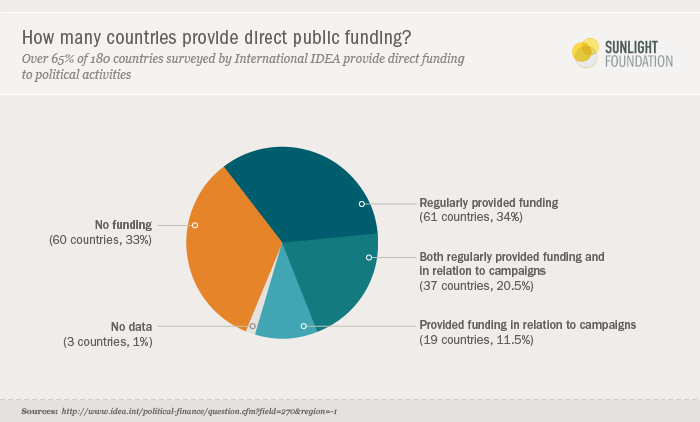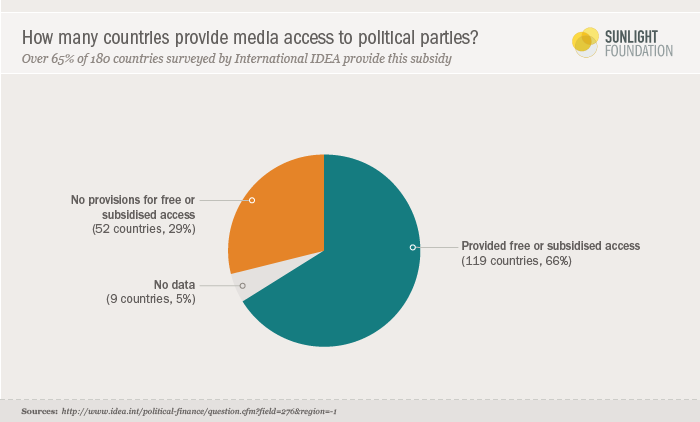Can public funding initiatives for political activity increase openness?
Money is an important fixture within a healthy democracy. Between the high advertising costs paid to gain media exposure during campaign periods, not to mention the day-to-day maintenance of the party, engaging in politics is an expensive endeavor.
Within the government accountability community, the focus of the conversation on political finance is often centered around the private sources of these funds, safeguarding against unchecked special interests’ influence and the subsequent policy distortion. Particularly at a U.S.-based organization, where parties are often criticized for out-of-control election spending backed by industry interests, it’s easy to forget the key role that public funding can have in shaping elections. It can diversify candidate lists, open up opportunities for minority parties to convey their messages and, sometimes, counteract the effects of private donations. When simultaneously faced with high election costs and the challenge to maintain trust in democratic institutions corrupted by special interests, what role can the public purse play in increasing openness and accountability of parties and elections?
Why public subsidies?
Providing subsidy for political entities is not a novel concept and the rationale behind these provisions are usually rooted in the belief that this relief can strengthen democracy. In the last 15 years, international organizations, including the Organization of American States, have recommended the institution of public funding into a political finance framework to ensure an equitable democratic process. The Organisation for Economic Co-operation and Development recognizes the increasing trend of public funding initiatives within its member states.

According to data provided by International IDEA, more than 65 percent of 180 countries surveyed provide some amount of “direct funding” to political parties or campaigns, either in the form of general support grants or earmarked funds for specific activities. But subsidies can also be provided indirectly; according to IDEA, at least 70% of countries do that.1 Such benefits include access to public meeting space for convenings, as is the case in Armenia. In the U.S., organizations dedicated to political activities enjoy special tax-exempt status. Political parties and candidates may also be granted broadcast airtime at a free or reduced rate. In Japan, a combination of both direct and indirect funding is employed: Once parties gain parliamentary seats and reach a 2 percent threshold of the popular vote, they are eligible for public subsidy. These provisions include direct funding, but also equitable access to free public airtime. Candidates are also subject to many of these benefits throughout campaigns.

Often these measures seek to mitigate the private influence that leads to policy capture or reduce the opportunities for quid pro quo corruption that may arise through fundraising. These provisions are not usually designed to eliminate private political donations altogether, but rather aim to reduce the pressure to raise funds that may not ultimately lead to public interest policies. In Germany, about one third of the budgets’ of national-level parties are comprised of public funds. In Uruguay, this portion is significantly higher, with public funds making up between 50 to 90 percent of the major parties’ overall budgets in recent election years. When significant padding is provided regularly from the state, parties know that they will receive the funds needed to subsist without having to resort exclusively to funds that may compromise policies and threaten public trust in institutions. However, there is widespread controversy over whether these measures are effective in actually reducing corruption. Part of this disagreement is due to corruption’s stealthy nature, which makes identifying a strong and universally-accepted approach to measuring it difficult. But these concerns are also supported by anecdotal evidence: Countries that provide significant public subsidy are not immune to corruption scandals. The Alternative for Germany party started selling gold in an attempt to become eligible for more public funding. In Japan, the former trade minister recently resigned after allegedly using political funds to treat supporters to movie theatre tickets. Her party, the Liberal Democrat Party, receives about 65 percent of its budget from state funds. Public funding may reduce pressure to raise money from private interests, but it cannot replace comprehensive anti-corruption measures and strong oversight of political finance regulations.
Another case for public subsidies is derived from a concept crucial to the frameworks of modern democracies: equality. Modern democracy rests on the belief that all are entitled to participate in the political process, and public subsidies are often designed to reduce the barrier to entry to ensure that new or minority voices can still be heard. Fostering political coalitions with fewer economic resources enhances competition, assuring that the players with greater resources can’t completely dominate the system. And as we’ve seen in countries like Uruguay, small parties are extremely reliant on these subsidies since it’s difficult for parties that don’t already have influence in office to garner private donors. This sentiment is not just directed toward burgeoning or small parties, but toward minority groups as well. For instance, women’s lack of access to the private financial resources necessary to campaign is often cited as a barrier to their running for political office, and there is a small but growing consensus that tying eligibility for direct public funding to gender equality can close this gap. In France, a political party can lose a portion of its public funding if there is a greater than 2 percent difference between the number of male and female candidates. After this policy was enacted in 1999, 47.5 percent of elected councilors in the following election were women.2
Public funding as a tool for transparency
Providing public subsidy can be a powerful tool in contributing to a healthy and competitive democracy, but it can also have a profound effect on transparency of additional private sources of political funding as well as the system of funding campaigns and parties generally.
First of all, public income does not fall prey to some of the arguments against greater financial disclosure. Often the protection of privacy is cited as a concern against disclosing political donor information. Although the Sunlight Foundation believes that the public’s right to know who is influencing the vote greatly outweighs this concern, when individual or corporate donors are taken out of the equation, these privacy arguments also vanish.
Further, due to the “public” nature of these subsidies, citizens and watchdogs have a right to put stipulations on how taxpayer money is allocated and used, and these stipulations can encourage transparency. Eligibility for public subsidies can be tied to reporting requirements of overall income and activities by parties and candidates, or, any other political finance regulation, really. There is, however, an important caveat to this initiative: Incentives have to be high enough to persuade parties and candidates that following the rules outweighs the benefits of non-compliance. And sometimes there are simply no incentives high enough. New York state has a robust public matching program, in which candidates can opt in to receive public funding if they file a financial disclosure report with the Conflicts of Interest Board. Candidates for city mayor in New York can receive more than $3.5 million in direct public funds per election, but when a New York City mayoral candidate has a net worth of more than $35 billion, why play by the rules for chump change?
Just as the institution of public funding programs can make the case for increased reporting of political finance information, the sheer amount of data that will then be available can in turn make the case for better political finance data. Financial reporting by parties and candidates is just the first step; investing in good disclosure practices on the part of the electoral mechanism is the only way to ensure that civil society and journalists can bring an eye of accountability to the data. And as the amount and detail of this data increases, the need to easily mill through this information is more pertinent to bring meaning to the data itself, find connections with related data sets and even help the oversight mechanisms more easily perform basic auditing functions. More data necessitates an investment in quality campaign finance portals and open data infrastructure.
Conclusion
Effective policies are not designed in a vacuum. They should be crafted and subsequently implemented with a prescribed intent while simultaneously acknowledging challenges in the political climate and culture. In the case of public subsidy, we often ask: If we want to cultivate a healthy democracy in which any viable candidate can run for office, what features should we attribute to our election policy, given both the tractable and intractable factors? Reducing eligibility requirements so that more parties or candidates have access to public benefits or increasing the frequency of disbursement to help parties stay afloat outside of prime election years are often cited as variables to foster this aim.
But what if the goal is to shape public funding policies that foster transparency in political finance? In that case, we should consider molding incentives and participation requirements that foster this aim and, ultimately, increase public access to this information. With the eyes of journalists, civil society and citizens on this data, they will have the information to hold their government to account — and this power can be just as crucial in cultivating a healthy democracy.
1 This survey does not include all sources of indirect funding as access to free or subsidized media for political parties or candidates, another common form of indirect subsidy, is not included. According to IDEA, 66.1 percent of countries surveyed provide this benefit to political parties and 46.7 percent provide this benefit to candidates.
2 Lolita Cigane and Magnus Ohman, Political Finance and Gender Equality, Washington, D.C.: International Foundation for Electoral Systems, 2014, 9.

